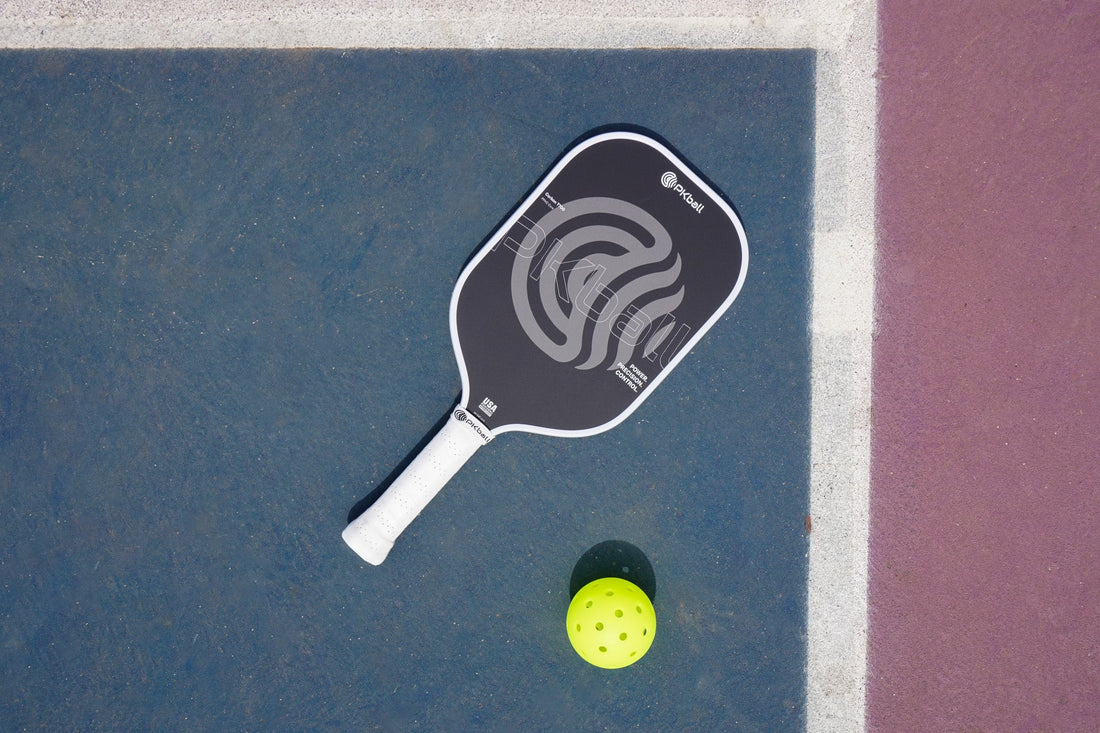
How to Choose the Perfect Pickleball Paddle for Your Game
Share
If you’re stepping into the world of pickleball or even if you’re a seasoned player looking to upgrade your gear, choosing the right paddle can feel like navigating a maze. With countless options flooding the market, from lightweight designs to heavy hitters, the fear of wasting money on the wrong paddle is real. At PKball, we get it: you want a paddle that feels like an extension of your arm, not a costly mistake. That’s why we’ve put together this pickleball paddle guide to help you cut through the overwhelm and find the perfect fit for your game. Let’s dive in and explore how to choose a pickleball paddle that matches your style, skill level, and goals.
Why Your Paddle Matters
Your pickleball paddle isn’t just a tool, it’s your partner on the court. The right paddle can boost your control, power, and confidence, while the wrong one can leave you frustrated and out of sync. With so many shapes, weights, and materials to consider, it’s easy to feel lost. But don’t worry- by focusing on a few key factors, you can narrow down your options and invest in gear that elevates your play. Whether you’re searching for the best pickleball paddle for beginners or a high-performance model for competitive matches, this guide has you covered.
Step 1: Understand Paddle Weight
One of the first decisions you’ll face is paddle weight, and it’s a biggie. Paddle weight affects how much power and control you bring to each shot, so it’s worth getting this right.
- Lightweight Paddles (7.4–7.8 oz): These are nimble and easy to maneuver, making them a top pick for beginners or players who prioritize control over power. They’re great for quick wrist action at the net and reduce arm fatigue during long games. If you’re just starting out, a lightweight paddle might be the best pickleball paddle for beginners to help you build confidence without overwhelming your swing.
- Midweight Paddles (7.9–8.4 oz): The sweet spot for many players, midweight paddles strike a balance between power and control. They’re versatile enough for all skill levels and playing styles, offering a solid mix of speed and punch. At PKball, our midweight options are fan favorites for their adaptability.
- Heavyweight Paddles (8.5 oz and up): Built for power, these paddles pack a wallop on drives and smashes. They’re ideal for advanced players or those with a strong baseline game, but they can feel sluggish at the net and may tire out newer players faster.
Pro Tip: Hold a paddle in your hand (or mimic the weight with something at home) to get a feel for what suits you. If you’re torn, start with a midweight - it’s the Goldilocks choice for most.
Step 2: Pick the Right Grip Size
A paddle that’s uncomfortable to hold is a recipe for disaster. Grip size is often overlooked, but it’s critical for avoiding strain and maintaining control. Here’s how to choose:
- Measure Your Hand: Use a ruler to measure from the tip of your ring finger to the bottom crease of your palm.
- Playing Style: Smaller grips favor quick wrist flicks and control, while larger grips suit power players and reduce wrist fatigue.
- Test It Out: If possible, borrow a friend’s paddle or visit a local shop. Your grip should feel secure but not cramped.
At PKball, we offer a range of grip sizes to ensure your paddle feels tailor-made. A poor fit can lead to blisters or even elbow pain, so don’t skimp on this step.
Step 3: Consider Paddle Materials
The material of your paddle influences its durability, feel, and performance. Here’s a breakdown of the most common options:
- Wood: Affordable and heavy, wood paddles are a budget-friendly entry point for beginners. They lack the finesse of modern materials but get the job done for casual play.
- Composite: Made from a blend of materials like fiberglass or carbon fiber, composite paddles offer a great mix of power and touch. They’re a step up in price but worth it for intermediate players.
- Polymer Core: Known for their soft, quiet feel, polymer-core paddles (often paired with composite faces) excel at control and spin. They’re a popular choice across skill levels.
New to the game? A polymer-core paddle might be the best pickleball paddle for beginners due to its forgiving feel. At PKball, we craft our paddles with premium materials to ensure you’re getting quality that lasts.
Step 4: Shape and Size
Paddle shape impacts your sweet spot—the area that delivers the cleanest, most powerful hits. Here’s what to know:
- Elongated: Longer and narrower, these paddles offer extra reach and power but a smaller sweet spot. Great for singles players or those with a long swing.
- Widebody: Wider than average, widebody paddles maximize the sweet spot for consistency and control - ideal for doubles or defensive play.
Your court position matters here. Net players might lean toward widebody designs, while baseline bashers might prefer elongated paddles. PKball’s lineup includes options for every shape preference, so you’re covered no matter your style.
Step 5: Factor in Your Skill Level
Be honest about where you’re at in your pickleball journey- it’ll save you money and frustration.
- Beginners: Focus on control-oriented paddles (light to midweight, larger sweet spot). You’re still mastering the basics, so avoid overspending on pro-level gear.
- Intermediate Players: Look for versatility. A midweight, composite paddle can grow with your skills as you refine your game.
- Advanced Players: Prioritize what your game needs - power, spin, or precision. You’ve earned the right to splurge on a paddle that matches your edge.
Not sure where you land? Chat with a pickleball buddy or try a few paddles at a local club. The right choice now sets you up for success later.
Step 6: Set a Budget
Paddles range from $20 to over $250, and it’s tempting to think pricier means better. But here’s the truth: the best paddle for you fits your needs, not your wallet’s limits. For beginners, a $80–$100 paddle offers solid performance without breaking the bank. Intermediate and advanced players might invest $100+ for durability and specialized features. At PKball, we design paddles that deliver value at every price point, so you’re not just buying gear- you’re investing in your game.
Avoid the Fear of Wasting Money
Here’s the bottom line: choosing the wrong paddle doesn’t have to be a costly mistake. Start with your priorities- weight, grip, material, and budget—and lean on this pickleball paddle guide to narrow your options. Still unsure? Reach out to the PKball community or customer support for personalized advice. We’re here to make sure your paddle feels right from the first swing.
Why PKball?
At PKball, we’re obsessed with helping you play your best. Our paddles are designed with input from players like you, blending innovation with practicality. Whether you’re searching for “how to choose a pickleball paddle” or hunting for the best pickleball paddle for beginners, we’ve got options that check every box- without the guesswork.
Ready to find your perfect paddle? Explore PKball’s collection today and step onto the court with gear that’s made for your game. Let’s play!
